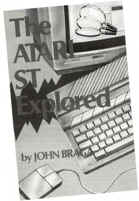|
Book
by John Braga
Kuma Computers Ltd.
£8.95
|
 |
All the well known publishers are working on or
have released their first ST books but here we have a book published
by a software company. Can it compete with the full time publishers?
You bet it can, it is probably the best book yet published for the
average user of the ST. Whilst it covers the usual introduction to
the system, and BASIC and LOGO it is full of little snippets which
others have failed to uncover and goes much further with good
details about aspects of the Operating Systems and how to access
them via 68000 machine code or C.
Even if you are already familiar with the GEM
environment reading through the introductory chapters of this book
will probably teach you one or two things you did not know such as
how to change the names of the disk drive icons or properly install
applications. Once you have read this section you should be quite
familiar with GEM and will feel quite comfortable in progressing
through the chapters dealing with the Operating System, VDI and BIOS
etc. The section on BASIC is quite small but does not mess around
and goes straight into VDISYS calls from BASIC and is therefore
likely to be of much more interest to experienced BASIC programmers
than other 'introductory' books. LOGO receives its usual mention
before the book introduces 68000 machine code via the K-SEKA
Assembler (published by guess who?) which, as far as I am aware, is
the first time a book has covered this specifically for the ST. From
here onwards, the heading of chapter 12 says it all - Hackers, Start
Here!
Over half of the book is devoted to all those
things that programmers want to know. Bits of code to show you how
to access windows, menus and the like. This section begins with a
list of memory addresses in low RAM and is followed by details of
the BIOS interface with a list of all the normal BIOS commands and
examples of how to use them in both C and Assembler. Next comes the
TOS interface and the GEM interface and the 'Line A' interface. All
these are treated in similar fashion with a full list of commands
and Assembler routines for you to explore and put into your own
programs. Finally comes four real problems or programming projects
to show you how to put all this knowledge to good use.
The projects include how to alter the RAM based
TOS, how to change the on-screen font, how to change the 'fixed'
icon descriptions and how to patch in a directory printer. Work
through these and you should be well on your way to building your
own programs.
The book is rounded off with a discussion of
accessing the outside world through the serial port which will help
a lot of people and a round up of software which will inevitably
become dated but is a good reference for the first time buyer.
In my opinion Kuma have come up with the best book
so far published on the ST. It covers far more than many of the
books so far published, which often have been just an extension of
the manual, and is ideal for anyone who has some experience of
computing but little knowledge of the ST. The only thing that lets
the book down is lot of 'jokey' notes such as 'This is a diagram of
a blank page' which tend to make anyone flicking through the book
think that it is just another worthless tome whose author is
struggling to fill the pages. Not so. A fine book published in
Britain and priced at just £8.95. If you want to do more than just
click that mouse on ready made programs you will find your money
well spent.
top